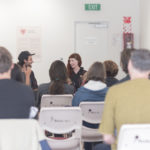



Lunchtime Discussion #1
Two red chairs, A and B, facing fifteen or so other red chairs: this is the stage for a performance of a Relay-Interview, a game adopted from Jacob Wren’s model. The person in chair B speaks an answer to a question that the person in chair A asks, then rejoins the audience. The answering baton is passed to the questioner who, becoming the answerer, waits for someone in the audience to join them in Chair A .
If it is not already clear, this quickly poses a risk. Should I do it? Will someone else get there first? Sitting in chair A gives you a chance to steer the conversation towards something particular; you are given no guarantee of a response, though; the person in chair B gets to answer however, and there is a sense that asking a question is asking on behalf of the audience, for the answer will be given to them all.
Does it matter who a question is directed to, if they can answer it? Does the answer matter then, or the question? Does it matter in a different way? Does the answerer trust the audience implicitly even if they feel uncomfortable? Does the set-up permit a postponement of some social rules to leave room for responses brushed by vulnerability? Does the game make responding to discomfort part of the performance?
While waiting for someone to occupy chair A: pauses, quiet, eye contact and not, different socks, tapping hands on quads in a rhythm, sweating palms, trembling fingers, hands held between the thighs, laughter, cool, yeah, sweet, cheers, looking above the heads of the audience, silences, readjusting skirts and shirts, biting the inside of lips, swallowing, looking at the black and white video performance on the TV.
While answering in chair B: pauses, looking at the ceiling, ummm, aaahmmm, laughter, waiting, thinking that there is thinking going on, discomfort, stop-start, the audience watching you think, nodding, looking at the person in chair A briefly, eye contact and not, the self-consciousness about taking space and the privilege of speaking, awareness thrumming, awareness of the open air, awareness of the deep end.
At the game’s end, clapping. The rushing clouds of public social norms rejoin the spaces between the people who don’t know each other and those who do. Chairs are put away, the audience dissolving into conversations at a volume publicising their privacy, and those who loaf, introduce themselves, admire the art, say thanks or squirm or both, then put sunglasses on and walk out the door into the sunshine on Cuba Street.

A selection of latent thoughts that simmered:

Cris Cucerzan on An Artist Relay: Lunchtime Discussion #1